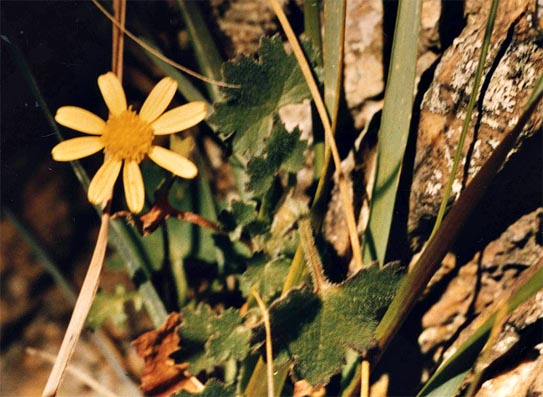BIODIVERSITY: Endemic Plants
Cineraria ngwenyensis Cron

Cineraria ngwenyensis Cron
Information extracted from "A revision of the genus Cineraria (Asteraceae, Senecioneae)", Glynis V. Cron, Kevin Balkwill & Eric B. Knox, Kew Bulletin 61(4) 449 - 535.
Description: Perennial herb, to 0.4 m tall. Stems woody and branching slightly towards the base, brown to reddish brown, often drying straw-coloured in upper parts, densely hairy. Leaves reniform to deltoid-reniform, very distinctly (3 –) 5 - 7-lobed, uppermost leaves occasionally with 1 or 2 pinnae, rarely pinnatisect into 3 or 5 distinct parts; lamina 5 - 19 × 6 - 31 mm, green, sometimes tinged reddish-purple, hairy to very densely hairy above and below; apex obtuse to rounded; margin coarsely dentate; base subcordate to cordate; petiole 8 - 35 mm long, hairy; auricles small, caducous, auriform and usually dissected into two lobes on either side of petiole. Capitula heterogamous, radiate, few (mostly 2 - 4, occasionally as many as 8) in a lax panicle; peduncles (12 –) 16 - 52 (– 55) mm long, sparsely hairy, glabrescent, with few or many small bracts 2 - 3 mm long. Involucre calyculate; phyllaries 12 or 13, 4 - 5 mm long, glabrous; margins scarious. Ray florets 8 or rarely 9, 5.0 - 8.0 mm long; limb 3.5 - 6.0 mm long, distinctly 4-veined (rarely 6-veined), veins reddish-brown. Disc florets 26 - 32; corolla (3.5 –) 4.0 - 5.0 mm long, veins reddish-brown. Cypselae obovate, compressed with a median rib evident in mature cypselae, margined (to narrow-winged), brown or black with paler margins, 2 - 3 mm long, glabrous. Pappus to base of disc corolla lobes.
Habitat: In shade of rocks on mountain slopes and north-west facing spurs, near the summit of the quartzite ridges in Swaziland, adjacent to iron-ore bearing rocks; 1500 - 1700 m.
Distribution: Swaziland, Ngwenya Hills (including Bomvu Ridge).
Flowering season: Flowering April to June.
Discussion: Cineraria ngwenyensis, known only from the Ngwenya Hills in Swaziland (Figure 16A), is similar to C. lobata in growth form and leaf shape, but its cypselae are completely glabrous (Figure 16B, D), as opposed to those of C. lobata which are hairy on either the margins only or both margins and faces. Its stems and leaves are densely covered with hairs (Figure 16C, E), while C. lobata is commonly glabrous or sparsely hairy, except for a hairy form in the Western Cape, but then the trichomes differ. The trichomes in C. ngwenyensis are 10 - 12 cells long and eglandular, gradually tapering (Figures 3B2, 16Ff), but do not have the long apical appendage of the trichomes seen in the hairy form of C. lobata subsp. lobata. In addition, its involucral bracts are glabrous, whereas they are pilose in the hairy form of C. lobata subsp. lobata, which also usually has only 5 rays in contrast to the 8 or 9 rays present in C. ngwenyensis. The auricles of C. ngwenyensis are ovate to lanceolate in shape (Figure 16E), as opposed to the auriform auricles commonly seen in C. lobata. They do however match the auricles of C. lobata subsp. soutpansbergensis, but that taxon has glabrous or cobwebby, glabrescent leaves and its cypselae are ciliate and hairy.
The Ngwenya Hills in the Malolotja Nature Reserve in Swaziland fall into the Barberton Centre of Endemism, characterised by a complex and unique succession of deformed volcanic and sedimentary strata (the Barberton Supergroup). Most of the endemics in this centre are grassland endemics, though not many are Asteraceae (Van Wyk & Smith 2001). This species occurs amongst the quartzite outcrops in the montane grassland of the high plateau (Figure 16A), which also has clear links with the Afromontane Region. It may well occur on similar, less accessible peaks and plateaux in the reserve.
IUCN Red List assessment: Very rare and restricted in distribution with small populations, but it is protected within the Malolotja Nature Reserve. It qualifies as Vulnerable (VU D2), as its area of potential occupancy is estimated at about 100 km2 as it occurs only amongst the rocky outcrops on the mountains. Currently it is known only from three localities.
Known Collections: SWAZILAND: Mbabane District, Bomvu Ridge, Compton 28822 (NBG, PRE); about 20 km N of Mbabane, Ngwenya Hills, Castle Peak, Lion Cavern, 7 April 1966, Maguire 7626/80 (J); Ngwenya Hills, Castle Peak, Maguire 7590 (J, K); Ngwenya Hills, W of Lion Cavern, 24 June 1995, Cron, Balkwill & Balkwill 308 (holotype J, isotypes K, MO, PRE, S); Ngwenya Plateau, 24 June 1995, Cron, Balkwill & Balkwill 311 (J).

